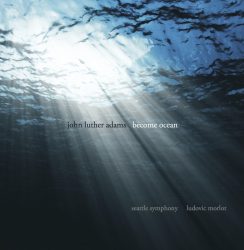Looking at the ocean, the first thing you see is the ‘bigger picture’: the slow movement on the horizon, the waves rolling in.
Then, gradually, more details unfold: you see fractal images of waves within waves. The image never changes, but it’s never the same either, and the longer you look the more you see.
This is the exact effect that John Luther Adam‘s 42 minute piece “Become Ocean“ has – in sound.
The piece was composed for the Seattle Symphony and brought to life by their music director Ludovic Morlot. It won the 2014 Purlitzer Prize, and is now finally available in a CD/DVD version (with the DVD presenting a surround mix for maximum sonic immersion!).
“Become Ocean” was inspired by the oceans of Alaska and the Pacific Northwest, and the references to the endless oceanic movement are clear from the very beginning. Like there are different ways to look at the ocean’s movement, there are also are different ways to listen to this piece: you can just ‘follow the larger structure’, but you can also focus on the multitude of details underneath it.
It’s not often that you hear an immersive piece like this performed by a full scale symphony orchestra:
“The bulk of the orchestra is split into its three natural groups, full-sized strings, woodwinds and brass sections. Each group is given slowly moving sequences of sound, often in the form of arpeggios for the strings, and each block has its own rise and fall. Thus the groups overlap in en ever-changing pattern. Harmonies are fundamentally tonal; simple diatonic intervals form the basis of the wind instruments’ staggered chords. The phrase lengths are constructed so that there are three moments when all the groups reach a climax together; the first is early on, and the second represents the greates surge of sound. From that point: the music is played in reverse: the entire piece is a palindrome.
Underlying this pattern, a rippling effect is provided by a centrally placed piano (which plays continuously throughout), four harps, celesta, one percussionist on bass drums, timpani, tamtam and cymbals, and two percussionists , placed on each side, on mallet instruments)”
(description taken from Wikipedia)
In a way, “Become Ocean“ could be seen as ‘minimal’ music. But maybe it’s more like ‘contemporary maximalism’ – “music that embraces heterogeneity and allows for complex systems of juxtapositions and collisions.” (David A. Jaffe)?
I guess it’s best to leave qualifications like that for what they are, and just surrender to the sound.
“We’re made up mostly of water, and life on earth first emerged from the seas. And with the melting of the polar ice caps and the rising sea levels, we may become ocean sooner than we imagine.”
The composition’s title, by the way, comes from a last line of a poem by John Cage, describing the music of his friend Lou Harrison: “Listening to it, we become ocean”.
I don’t know of any other composition that fits this description as well as “Become Ocean” does!

JOHN LUTHER ADAMS – BECOME OCEAN (excerpt)


